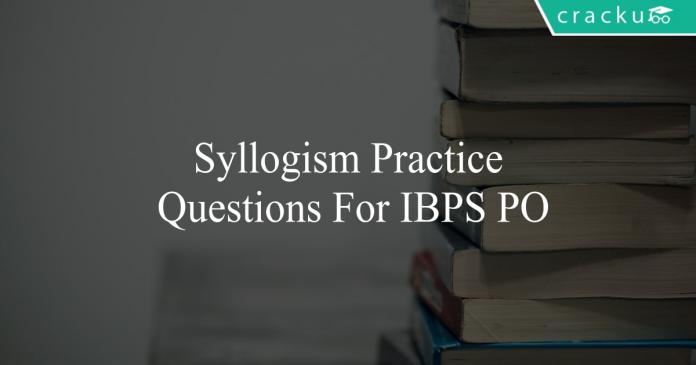Syllogism Practice Questions For IBPS PO
Download important Syllogism Questions PDF based on previously asked questions in IBPS PO and other Banking Exams. Practice Syllogism Question and Answers for IBPS PO Exam.
Download Syllogism Practice Questions For IBPS PO
Take 4 Free mock tests for IBPS PO
Download IBPS PO Previous Papers PDF
Question 1: Statements:
Some exams are tests.
No exam is a question.
Conclusions:
I. No question is a test.
II. Some tests are definitely not exams.
a) If only conclusion I follows
b) If only conclusion II follows
c) If either conclusion I or conclusion II follows
d) If neither conclusion I nor conclusion II follows
e) If both conclusion I and conclusion II follow
Question 2: Statements:
All forces are energies.
All energies are powers.
No power is heat.
Conclusions:
I. Some forces are definitely not powers.
II. No heat is force.
a) If only conclusion I follows
b) If only conclusion II follows
c) If either conclusion I or conclusion II follows
d) If neither conclusion I nor conclusion II follows
e) If both conclusion I and conclusion II follow
Question 3: Statements:
All forces are energies.
All energies are powers.
No power is heat.
Conclusions:
I. No energy is heat.
II. Some forces being heat is a possibility.
a) If only conclusion I follows
b) If only conclusion II follows
c) If either conclusion I or conclusion II follows
d) If neither conclusion I nor conclusion II follows
e) If both conclusion I and conclusion II follow
IBPS PO Quant Formulas & Shortcuts
Question 4: Statements:
No note is a coin.
Some coins are metals.
All plastics are notes.
Conclusions:
I. No coin is plastic.
II. All plastics being metals is a possibility.
a) If only conclusion I follows
b) If only conclusion II follows
c) If either conclusion I or conclusion II follows
d) If neither conclusion I nor conclusion II follows
e) If both conclusion I and conclusion II follow
Question 5: Statements:
No note is a coin.
Some coins are metals.
All plastics are notes.
Conclusions:
I. No metal is plastic.
II. All notes are plastics.
a) If only conclusion I follows
b) If only conclusion II follows
c) If either conclusion I or conclusion II follows
d) If neither conclusion I nor conclusion II follows
e) If both conclusion I and conclusion II follow
Question 6: Statements:
Some symbols are figures.
All symbols are graphics.
No graphic is a picture.
Conclusions:
I. Some graphics are figures.
II. No symbol is a picture.
a) If only conclusion I follows
b) If only conclusion II follows
c) If either conclusion I or conclusion II follows
d) If neither conclusion I nor conclusion II follows
e) If both conclusion I and conclusion II follow
Question 7: Statements:
All vacancies are jobs.
Some jobs are occupations.
Conclusions:
I. All vacancies are occupations.
II. All occupations being vacancies is a possibility.
a) If only conclusion I follows
b) If only conclusion II follows
c) If either conclusion I or conclusion II follows
d) If neither conclusion I nor conclusion II follows
e) If both conclusion I and conclusion II follow
Instructions
Directions : In each of the question below are given four statements followed by four conclusions numbered I, II, III and IV. You have to assume everything in the statements to be true even if they seem to be at variance from commonly known facts and then decide which of the four given conclusions logically follows from the statements disregarding commonly known facts and select the appropriate answer.
Question 8: Statements:
Some numbers are digits.
All digits are alphabets.
No alphabet is a vowel.
All consonants are vowels
Conclusions:
I. No digits is a vowel.
II. No alphabet is a consonant.
III. No vowel is a number.
IV. All vowels are numbers.
a) Only I and III follow
b) Only II and IV follow
c) Only I and II follow
d) Only I, II and III follow
e) Only I, II and either III or IV follow
Question 9: Statements:
All documents are files.
Some files are papers.
All papers are certificates.
No certificate is a manuscript.
Conclusions:
I. At least some documents are papers.
II. No manuscript is a document.
III. At least some certificates are files.
IV. No paper is a document.
a) Only I, II and IV follow
b) Only II and III follow
c) Only I and IV follow
d) Only III follow
e) None of these
Question 10: Statements:
No group is people.
All people are animals.
All animals are plants.
All plants are roots.
Conclusions:
I. No group is a plant.
II. All people are plants.
III. At least some groups are plants.
IV. All plants are groups.
a) Only II follows
b) Only I and IV follow
c) Only II and III follow
d) Only III and IV follow
e) None of these
Question 11: Statements:
Some jobs are vacancies.
All jobs are works.
No work is a trade.
All professions are trades.
Conclusions:
I. At least some works are jobs.
II. No vacancy is a trade.
III. No profession is a work.
IV. At least some works are professions.
a) All I, II, III and IV follow
b) Only II, III and IV follow
c) Only I and IV follow
d) None follows
e) Only I and III follow
Question 12: Statements:
All marks are grades.
No grade is a score.
All letters are scores.
All scores are characters.
Conclusions:
I. At least some letters are grades.
II. At least some scores are grades.
III. At least some characters are marks.
IV. Some characters are letters.
a) Only II and IV follow
b) Only IV follows
c) Only I and III follow
d) All I, II, III and IV follow
e) None follows
Instructions
In each of the question below are given three statements followed by two conclusion numbered I and II. You have to take the given statements to be true even if they seem to at variance from commonly known facts and then decide which of given conclusion logically follows from the statements disregarding commonly known facts Give answers–
A If only conclusion I follows
B If only conclusion II follows
C If either conclusion I or conclusion II follows
D If neither conclusion I nor conclusion II follows
E If both conclusion I and II follows
Question 13: statements:
some casual are formal.
All formal are expensive.
All expensive are elegant.
Conclusion:
I.All formal are elegant
II.Some casual are expensive
a) If only conclusion I follows
b) If only conclusion II follows
c) If either conclusion I or conclusion II follows
d) If neither conclusion I nor conclusion II follows
e) If both conclusion I and II follows
Question 14: Statements:
All roses are red.
Some red are colour.
All colour are paints.
Conclusion:
I. Some red are paints.
II. All red are roses.
a) If only conclusion I follows
b) If only conclusion II follows
c) If either conclusion I or conclusion II follows
d) If neither conclusion I nor conclusion II follows
e) If both conclusion I and II follows
Question 15: statements:
All towns are cities.
All cities are urban.
Some urban are rural.
Conclusion:I. Some towns are rural.
II. All rural are towns.
a) If only conclusion I follows
b) If only conclusion II follows
c) If either conclusion I or conclusion II follows
d) If neither conclusion I nor conclusion II follows
e) If both conclusion I and II follows
IBPS PO Previous Papers (Download Pdf)
Question 16: statements:
All medicines are tablets.
Some tablets are tonics.
Some tonics are bitter.
Conclusion:
I. Some tablets are bitter.
II. No medicines is a tonic.
a) If only conclusion I follows
b) If only conclusion II follows
c) If either conclusion I or conclusion II follows
d) If neither conclusion I nor conclusion II follows
e) If both conclusion I and II follows
Question 17: statements:
All incomes are salaries.
Some salaries are perks .
Some perks are tangible.
Conclusion:
I. Some incomes are tangible.
II. At least some perks are salaries.
a) If only conclusion I follows
b) If only conclusion II follows
c) If either conclusion I or conclusion II follows
d) If neither conclusion I nor conclusion II follows
e) If both conclusion I and II follows
Instructions
In each of the question below are given three statement followed by two conclusions numbered I and II. You have to take the given statements to
be true even if they seem to be at variance from commonly known facts and then decide which of the given conclusions logically follows from the statements
disregarding commonly known facts.
Question 18: Statements:
All petals are flowers.
some flowers are not petals.
some petals are colours.
Conclusions:
I. Some flowers are colours.
II. Some flowers are not colours.
a) If only conclusion I follows.
b) If only conclusion II follows.
c) If either conclusion I or conclusion II follows
d) If neither conclusion I nor conclusion II follows
e) If both conclusion I and II follow.
Question 19: Statements:All desks are tables.Some tables are drawers.Some drawers are big.Conclusions:I. Some tables are big.II. No desk is adrawer.
a) If only conclusion I follows.
b) If only conclusion II follows.
c) If either conclusion I or conclusion II follows
d) If neither conclusion I nor conclusion II follows
e) If both conclusion I and II follow.
Question 20: Statements:All colleges are buildings.All buildings are concreteSome concrete are strongConclusions :I. Some colleges are strong.II. At least some strong are concrete.
a) If only conclusion I follows.
b) If only conclusion II follows.
c) If either conclusion I or conclusion II follows
d) If neither conclusion I nor conclusion II follows
e) If both conclusion I and II follow.
Answers & Solutions:
1) Answer (D)

Nothing can be built between tests and questions from this information.
Some exams are tests doesn’t mean some tests are not exams because this could be a case where all tests are exams.
Hence neither of the statements is true.
2) Answer (B)
All forces are energies and all energies are powers => all forces are powers. => conclusion 1 is wrong
No power is a heat and all forces are powers => No heat is force.
Only conclusion 2 follows.
3) Answer (A)
All forces are energies, all energies are powers and no power is heat => no energy is heat => Conclusion 1 is correct
No force is heat => Conclusion 2 is wrong.
Hence only conclusion 1 follows.
4) Answer (E)
All plastics are notes and no note is a coin => no coin is plastic => Conclusion 1 follows.
Some coins are metals => Some notes being metals is a possibility => All plastics being metals is a possibility => Conclusion 2 follows.
=> Both follow
5) Answer (D)
No plastic is a coin and some coins are metals => Some metals being a plastic is a possibility => Conclusion 1 is wrong
All plastics are notes does not imply all notes are plastic => Conclusion 2 is wrong
Hence neither of the conclusions is correct
6) Answer (E)
All symbols are graphics and some symbols are figures => some graphics are figures => conclusion 1 follows
All symbols are graphics and no graphic is a picture => no symbol is a picture => conclusion 2 follows
=> Both conclusions follow
7) Answer (B)
Only some jobs are occupations => conclusion 1 is wrong
It is possible that all occupations are vacancies => conclusion 2 is correct
Therefore only 2 follows
8) Answer (C)
Using the Venn diagrams, the statements 1 and 2 are implied.
9) Answer (E)
From the statements, we can draw a venn diagram as follows. Hence, statement II is definitely not true.

As some papers are files, some certificates are definitely files. Hence, statement III is true.
Statement I and IV are mutually exclusive and collectively exhaustive. Hence, either I or IV is true.
Thus, statement III and either I or IV follow. Hence, the answer is none of the above.
10) Answer (A)
As per the Venn diagram alongside, only conclusion 
11) Answer (E)
As per the Venn diagram alongside, both conclusions 1 and 3 follow.
12) Answer (B)
All letters are scores and all scores are characters. So, some characters are definitely letters.
The other three conclusions do not necessarily follow. So, option b) is the correct answer.
13) Answer (E)
Some casual are formal.
All formal are expensive. Hence, some casuals are expensive.
All expensive are elegant. Hence, all formals are elegant and some casuals are elegant.
Therefore, both I and II follow.
14) Answer (A)
The data can be intrepreted in syllogisms form as:
Some red are paints.This conclusion can be drawn as apparent from Venn diagram.
All red are roses.This is obviously a wrong conclusion.
Hence, only I follows.
15) Answer (D)
The data can be intrepreted in Venn diagram from as:
Some towns are rural. We cannot say this with surety and this conclusion can be contradicted.
All rural are towns.This definitely cannot be concluded from Venn diagram.
Hence, both conclusion I and II do not follow.
16) Answer (D)
Data can be intrepreted in Venn diagram form as:
Some tablets are bitter. This conclusion cannot be drawn from the Venn diagram.
No medicines is a tonic.This conclusion also cannot be drawn.
Both I and II do not follow.
Option D is correct option.
17) Answer (B)
Data can be intrepreted in Venn diagram form as:
Some incomes are tangible. The income and tangibles are disjoint sets. Hence, conclusion drawn is incorrect.
At least some perks are salaries. This conclusion is correct. There is intersection betweem perks and salaries set.
18) Answer (A)
The data in Venn diagram format can be intrepreted as:
Some flowers are colours. This conclusion can be drawn as there is intersection between Flowers and Colours set.
All flowers can be colors. In a similar way all petals can be colors. Hence, only conclusion I follows.
19) Answer (D)
Some tables are big. This conclusion cannot be drawn. Big and Tables is disjoint set.
No desk is a drawer. This conclusion also cannot be drawn with surety as there might be intersection between Drawers and Desks
Both I and II do not follow.
20) Answer (B)
The data can be intrepreted in Venn diagram form as:
Some colleges are strong.We cannot draw this conclusion with assurance.
At least some strong are concrete. This conclusion can be drawn with surety as apparent from Venn diagram.
Only II follows. Option B is correct.







